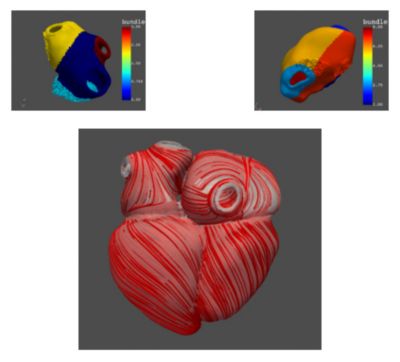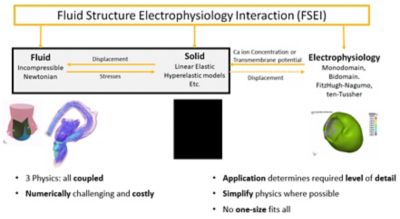-
United States -
United Kingdom -
India -
France -
Deutschland -
Italia -
日本 -
대한민국 -
中国 -
台灣
-
Ansys is committed to setting today's students up for success, by providing free simulation engineering software to students.
-
Ansys is committed to setting today's students up for success, by providing free simulation engineering software to students.
-
Ansys is committed to setting today's students up for success, by providing free simulation engineering software to students.
-
Contact Us -
Careers -
Students and Academic -
For United States and Canada
+1 844.462.6797
ANSYS BLOG
May 6, 2024
Get to the Heart of the Matter
Ansys’ dedicated Healthcare Research team is hoping to revolutionize the treatment of cardiovascular and other diseases with their innovative modeling methods.
Engineering simulation has made critical contributions to healthcare research since it was first introduced more than 50 years ago. But most customers don’t realize that Ansys has a dedicated group, the Ansys Healthcare Research team, that increases the impact and scale of those contributions by pioneering innovative new modeling techniques for medical applications.
This team, primarily based in Europe, includes highly qualified, doctorate-level engineers and students who focus on a range of healthcare topics including brain studies, orthopedic models, and respiratory system simulations. Some members are embedded in leading hospitals to facilitate collaboration and real-world validation of the team’s biological models.
By perfecting a new set of best practices and disseminating them to Ansys customers, the team is helping translate advanced simulation theory to practical real-world applications. One of its primary goals is to democratize advanced simulation methods by making them more accessible to non-simulation experts, then putting them in the hands of a range of academic, clinical, and industrial partners.
These collaborators can leverage advanced modeling practices to design new healthcare devices, diagnostic methods, and treatment plans — and, ultimately, develop personalized models that reflect the (patho)physiological state of actual human patients, i.e., personal digital avatars. Eventually, the hope is that medical innovators can use these models for two purposes:
- Test innovative new treatments on a specific patient’s “digital twin” before implementing them.
- Create virtual cohorts of large numbers of patients to provide evidence that treatments are safe and effective.
A New, Noninvasive View of Cardiovascular Disease
Since 2019, the Ansys Healthcare Research team has been addressing some of the most urgent challenges in healthcare. One of those challenges is improving the detection and treatment of cardiovascular diseases, the leading cause of death worldwide.
According to the World Health Organization, cardiovascular disease causes nearly a third of all deaths globally — a statistic that’s on the rise despite modern medicine and research efforts.
The world’s academic institutions, hospitals, and private companies are heavily investing in efforts to understand the fundamental mechanisms of cardiovascular disease. But a clear obstacle is an inability to measure the clinically unmeasurable inside the heart through in vivo, or even ex vivo, studies.
Computer simulation offers a low-risk, noninvasive, increasingly realistic alternative. Simulation can provide additional, otherwise unmeasurable but relevant metrics, and consequently improve clinicians understanding of the diseases. While it will never replace in-vivo studies entirely, the in-silico modeling approach enables much faster, more efficient, and cost-effective studies of the human body, including the cardiovascular system, than in vivo human studies and trials — with absolutely no risk to human patients. Furthermore, these models help researchers better understand the fundamental mechanisms of human physiology and how it develops certain pathologies.

The geometry and orientation of the heart’s muscle fibers play a critical role in both structural strength and electrical excitation. PyAnsys Heart enables researchers to compute, visualize and use these fibers in subsequent simulations.
To make rapid progress in developing the right tools to understand, diagnose, and treat cardiovascular disease, the Ansys Healthcare Research team has devoted significant resources to a project it calls “PyAnsys-Heart.” For four years and counting, the members of the Healthcare Research team have used Ansys LS-DYNA software to model blood flow, tissue mechanics, and the electrophysiological behavior of the heart. These models allow for detailed studies of the real-world fluid structure electrophysiology interaction (FSEI) that characterizes a patient-specific beating human heart.
These detailed FSEI models replicate complex, otherwise hard to measure features of the heart in a noninvasive way, including structural stresses, electrical excitation, and muscle fiber orientation. These models also account for the pericardium — the double-layered, fluid-filled sack that surrounds the heart — and they also consider the heart’s valves and atria as boundary conditions.
Due to its multiscale and multiphysics nature, heart modeling is numerically and financially costly. In addition, it requires both theoretical knowledge and hands-on simulation expertise. That’s why the Ansys Healthcare Research team is working closely with clinical and academic partners to generate and provide these models to the world’s cardiovascular research teams.
The team’s PyAnsys-Heart Python library, enables users to generate both partial and full-heart anatomies and simulation models, and will soon be available to Ansys customers to facilitate their own heart modeling efforts.

Developing a realistic human heart model means bringing together three separate, tightly coupled physics to study fluid structure electrophysiology interaction (FSEI). This is beyond the capabilities of most healthcare research teams.
An Open Platform to Drive Broad Adoption
Because a key goal is to make the team’s models available to a wide range of users with a spectrum of research interests, PyAnsys-Heart models are based on the open-source Python programming language and feature an intuitive, user-friendly interface. They are fully compatible with other elements of the Python ecosystem. Even nonexperts can easily walk through the basic steps of preprocessing, simulation, and post-processing for the PyAnsys-Heart models.
PyAnsys-Heart models from Ansys enable users to reduce computational complexity, streamline workflows, and save time, labor, and other resources by focusing on components of the heart relevant for their own specific application. Researchers can conduct full, system-level simulations or only model fluid flows, tissue mechanics, or electrophysiological activity. The multiphysics capabilities of LS-DYNA include computational fluid dynamics (CFD) solvers, finite element analysis (FEA) solvers, and electromagnetic (EM) solvers in a single environment, making it the ideal tool for capturing the physical complexities of the human heart.
The first version of the PyAnsys-Heart modeling library has been tested on multiple publicly available heart geometries from actual human patients with heart failure. In the future, the Ansys Healthcare Research team hopes to enable users to create large cohorts of customized, patient-specific models as simulation capabilities advance.
By providing medical device manufacturers, university research teams, and clinicians with these building blocks, Ansys can support and help accelerate the development and adoption of innovative new devices, detection methods, and treatments. The open-source nature of PyAnsys means that it can easily be combined with researchers’ own internal efforts. Users can build on top of existing features in PyAnsys-Heart to build their own simulation workflows or models, and conduct simulations tailored to their own requirements.
Ansys is making a significant investment in the PyAnsys-Heart project, as it expects to see an enormous return in terms of improved patient outcomes — and, over the long term, a reduction in the number of people who suffer from cardiovascular disease each year. This will also lead to a wider adoption of simulation tools throughout the healthcare industry.

PyAnsys-Heart models developed by the Ansys Healthcare Research team provide a visual, graphical way to understand and study the complexities of a blood-filled, beating human heart.
Taking Healthcare Innovation to Heart
The PyAnsys-Heart project is just one way Ansys is committed to democratizing simulation to create social benefits.
Many companies and hospitals have access to their own databases of medical imaging of patient-specific hearts. For them, the PyHeart approach is an excellent way to exploit this valuable data. Some might be willing to create a general-purpose model of the heart that could be customized to different simulations; for this, they may need to use more general purpose, off-the-shelf tools.
Despite the excellence of available segmentation software, the general process to go from imaging to simulation can be time consuming and resource intensive, and may lead to unexpected challenges. A collaboration among Peggy Huang and Christoph Maurath of Ansys and George Hyde-Linaker and Chris Goddard of Synopsys led to a polished workflow using AI-driven AS Cardio from Synopsys to smoothly generate heart meshes from clinical imaging for import into LS-DYNA software.
Using this approach, and relying on off-the-shelf tools, it is possible to go from the 4D scan of a patient to accurately simulating the transient blood flow of a patient specific heart in LS-DYNA software in less than 20 minutes. Once a fine and robust mesh is available in LS-DYNA software, standard general purpose modeling including fluid, structure, electrophysiology, and some combination of these physics can be performed by the user. The workflow has been successfully tested on several hearts but its application to thousands of patient specific cardiac images would improve the workflow.

The reality is that, while simulation can drive incredible healthcare research results, many academic, clinical, and industrial development teams simply can’t afford to invest in hiring experienced engineers who are already trained in computational modeling solutions and methods. And there have traditionally been long delays associated with getting new users of simulation software up to speed when faced with the demands and challenges of multiphysics, multiscale biological modeling.
By forming a dedicated Healthcare Research team closely interacting with worldwide colleagues engaged with healthcare and making its PyAnsys Heart models available to customers, Ansys is doing its part to drive transformative innovations that can help in the fight against cardiovascular disease.
Learn more about how Ansys LS-DYNA software can help you with your healthcare innovations.











